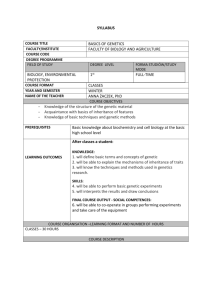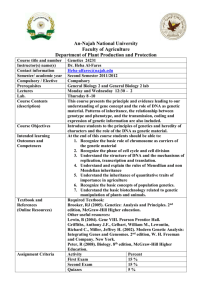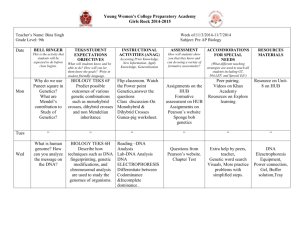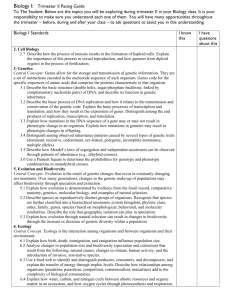AP Biology Syllabus - Mr. Multhaupt`s Biology Page
advertisement
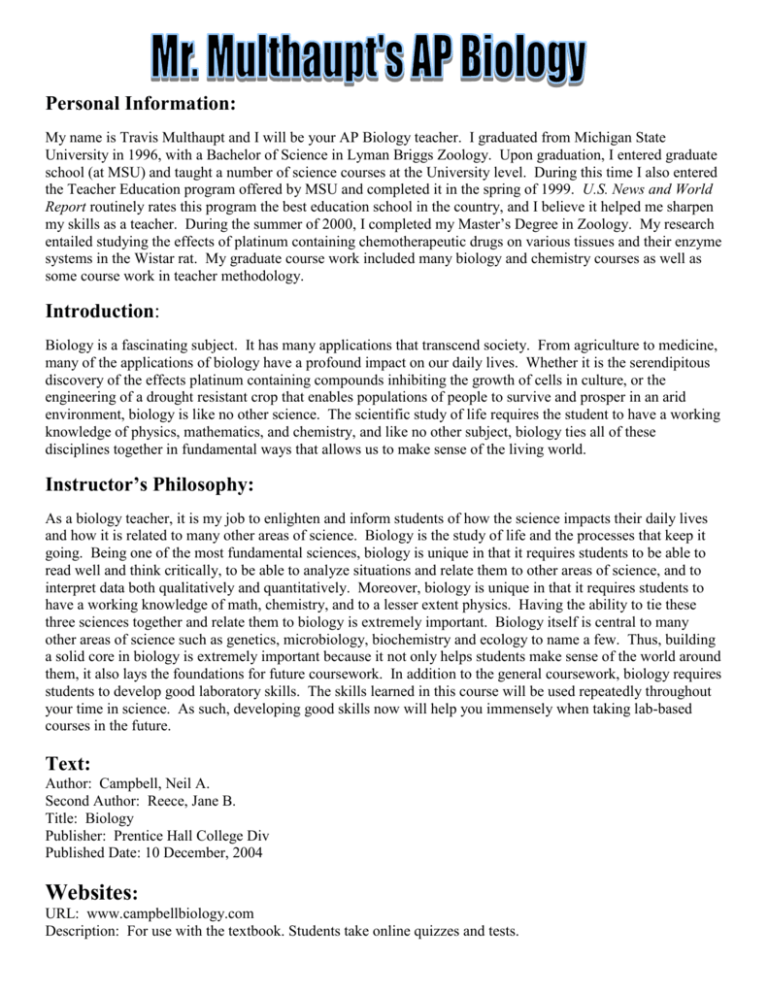
Personal Information: My name is Travis Multhaupt and I will be your AP Biology teacher. I graduated from Michigan State University in 1996, with a Bachelor of Science in Lyman Briggs Zoology. Upon graduation, I entered graduate school (at MSU) and taught a number of science courses at the University level. During this time I also entered the Teacher Education program offered by MSU and completed it in the spring of 1999. U.S. News and World Report routinely rates this program the best education school in the country, and I believe it helped me sharpen my skills as a teacher. During the summer of 2000, I completed my Master’s Degree in Zoology. My research entailed studying the effects of platinum containing chemotherapeutic drugs on various tissues and their enzyme systems in the Wistar rat. My graduate course work included many biology and chemistry courses as well as some course work in teacher methodology. Introduction: Biology is a fascinating subject. It has many applications that transcend society. From agriculture to medicine, many of the applications of biology have a profound impact on our daily lives. Whether it is the serendipitous discovery of the effects platinum containing compounds inhibiting the growth of cells in culture, or the engineering of a drought resistant crop that enables populations of people to survive and prosper in an arid environment, biology is like no other science. The scientific study of life requires the student to have a working knowledge of physics, mathematics, and chemistry, and like no other subject, biology ties all of these disciplines together in fundamental ways that allows us to make sense of the living world. Instructor’s Philosophy: As a biology teacher, it is my job to enlighten and inform students of how the science impacts their daily lives and how it is related to many other areas of science. Biology is the study of life and the processes that keep it going. Being one of the most fundamental sciences, biology is unique in that it requires students to be able to read well and think critically, to be able to analyze situations and relate them to other areas of science, and to interpret data both qualitatively and quantitatively. Moreover, biology is unique in that it requires students to have a working knowledge of math, chemistry, and to a lesser extent physics. Having the ability to tie these three sciences together and relate them to biology is extremely important. Biology itself is central to many other areas of science such as genetics, microbiology, biochemistry and ecology to name a few. Thus, building a solid core in biology is extremely important because it not only helps students make sense of the world around them, it also lays the foundations for future coursework. In addition to the general coursework, biology requires students to develop good laboratory skills. The skills learned in this course will be used repeatedly throughout your time in science. As such, developing good skills now will help you immensely when taking lab-based courses in the future. Text: Author: Campbell, Neil A. Second Author: Reece, Jane B. Title: Biology Publisher: Prentice Hall College Div Published Date: 10 December, 2004 Websites: URL: www.campbellbiology.com Description: For use with the textbook. Students take online quizzes and tests. Major Themes Which Will Appear Throughout This Course: 1. Science as a process—Science is a way of knowing. It can involve a discovery process using inductive reasoning, or it can be a process of hypothesis testing. 2. Evolution—Evolution is the biological change of organisms that occurs over an extended period of time and is driven by the process of natural selections. Evolution accounts for the diversity of life on Earth. 3. Energy transfer—Energy is the capacity to do work. All living organisms are active because of their abilities to link energy reactions to the biochemical reactions that take place within their cells. 4. Continuity and change—All species tend to maintain themselves from generation to generation using the same genetic code. However, there are genetic mechanisms that lead to change over time, (a.k.a. evolution). 5. Relationship of structure to function—The structural levels from molecules to organisms ensure successful functioning in all living organisms and living systems. 6. Regulation—Everything from cells to organisms to ecosystems is in a state of dynamic balance that must be controlled by positive or negative feedback mechanisms. 7. Interdependence in nature—Living organisms rarely exist alone in nature. 8. Science, technology and society—Scientific research often leads to technological advances that can have positive and/or negative impacts upon society as a whole. Major Topics That Will Be Covered During This Course: 1. 2. 3. 4. 5. 6. 7. 8. 9. The chemistry of life Cells Cellular energetics Heredity Molecular genetics Evolutionary biology Diversity of organisms Structure and function of plants and animals Ecology The Following Labs Will Enhance Your Understanding of Biology: Experiment 1: Experiment 2: Experiment 3: Experiment 4: Experiment 5: Experiment 6: Experiment 7: Experiment 8: Experiment 9: Experiment 10: Experiment 11: Experiment 12: Experiment 13: Experiment 14: Experiment 15: The Use of a Compound Light Microscope. Measurement Techniques. Microbiology: Slide Preparation and Bacterial Staining. Sterile Technique and Gram Staining. Chromosome Staining. Polytene Chromosomes of Drosophila melanogaster. Osmosis: A Model Cell and a Natural Model. DNA Extraction. Mendelian Genetics. Sex Linkage in Drosophila. Plant Water Relations Transpiration Peroxidase Enzyme Lab Feulgen Method for DNA Predator-Prey Simulation of Optimal Foraging By Birds on Different Prey Types in Different Habitats Experiment 16: Experiment 17: Experiment 18: Experiment 19: Experiment 20: Experiment 21: Experiment 22: Experiment 23: Experiment 24: Experiment 25: Experiment 26: Experiment 27: Experiment 28: Respiration of Germinating Seeds Bacterial Transformation Involving pGLO Recombination of Antibiotic Resistance Genes Ligation of pAMP and pKAN Restriction Fragments Transformation of E. coli with Recombinant DNA Classic Procedure for Preparing Competent Cells Transformation of E. coli With Recombinant pAMP/pKAN Plasmids Plant Pigments Photosynthesis The Genetics of Corn Lab Animal Behavior Dissolved Oxygen and Aquatic Primary Productivity Physiology of the Circulatory System More About The Course: Do not feel overwhelmed. Yes there is a lot of information that we will be covered, but I have had numerous students tell me that they felt very prepared for the AP exam. I have also been told by most of the students that despite the amount of work the class entails, they very much enjoyed the course. In this course you will be doing a number of things to enhance your understanding of biology. You will be taking lecture notes, performing labs, taking oral quizzes, online quizzes, and working on various assignments. Furthermore, in each chapter, you will have a list of vocabulary words—some which relate directly to science, and some which will serve to broaden your vocabulary. Additionally, you will be participating in the Reading Apprentice program which will require you to read a variety of different materials periodically throughout the week to sharpen your reading skills. This program will also require you to concentrate on four areas as they pertain to your reading skills: Think aloud, talk to the text, silent sustained reading, and the reading minute. In the think aloud, you will be asked to get with a partner and read through a passage while “thinking aloud” so as to demonstrate your thought process. This will help you (and your partner) to analyze the thinking process you go through while reading, and help you to “think about your thinking”—called metacognition. Talking to the text is essentially a think aloud on paper. For this technique, you will identify key vocabulary terms and main ideas to deeply analyze your thought process while reading. Additionally, you will use questioning strategies to analyze the reading, while paying attention to text structure. Silent sustained reading will be a 10-20 minute period where you will be asked to read quietly something you enjoy reading while at the same time concentrating on the skills you are learning as a Reading Apprentice. In the Reading Minute, you will be asked to find something to read in front of the class for one minute at three different times throughout the semester. Those not reading will listen quietly and write a one sentence summary about the reading when you are finished. The main goal of all of these strategies is to help you become a better critical reader and thinker. Participation in this program is mandatory and will serve as part of your grade. Tentative Grading Scale: 100%-94% 93%-90% A A- 89%-87% 86%-84% 83%-80% B+ B B- 79%-77% 76%-74% 73%-70% C+ C C- 69%-67% 66%-64% 63%-60% D+ D D- 59% and below F Students are required to come to class everyday with a pen/pencil, your AP Biology textbook (when instructed to do so), the lab manual, your agenda planner, and a three ring binder (when instructed to do so), (1 1/2 to 2 inches will suffice). In this binder is where you will file your homework assignments and any other papers which you receive. These papers are to be used to prepare for your quizzes and your unit tests, and at the end of the semester all assignments stored in this binder can be used to study for the midterm examination. Additionally, students will be asked to get a multi-subject notebook for taking lecture notes. The general outline of the course will vary from week to week, but will usually adhere to the following format: Day 1: Day 2: Day 3: Day 4: Day 5: Quiz, Lecture Quiz, Lecture, Pre-Lab Lab Lecture/Recitation Test/Quiz, Notes In general, we will cover two chapters per week. During some weeks we will cover numerous chapters, and during other weeks we will spend extended time on one chapter due to the difficulty of the material. Additionally, some of the labs we will perform will require more than one lab period, and thus we will be trimming down other portions of the week’s outline to accommodate this. Below is a list of chapters we will be covering: Unit I: The Chemistry of Life (Week 1) Chapter 1, Exploring Life: Exploring life from small to big. Biological diversity. Breaking down biological systems. Inquiry and the scientific method. Chapter 2, The Chemistry of Life: Elements and compounds. Atomic structure. Chemical bonding. Chemical reactions. Chapter 3, Water: Polarity and hydrogen bonding. Emergent properties of water. Acids and bases. Chapter 4, Carbon: Organic chemistry. Bonding and the carbon atom. The functional groups of molecules. Chapter 5, Macromolecules: Monomers, polymers, and macromolecules. Carbohydrates. Lipids. Proteins. Nucleic acids. Unit II: The Cell (Weeks 2-5) Chapter 6, A Tour of the Cell: The tools of biology and biochemistry. Eukaryotic cells, their internal membranes and their functions. Genetic instructions from the nucleus to the ribosome. The endomembrane system. Mitochondria and chloroplasts. The cytoskeleton. Extracellular components. Chapter 7, Membrane Structure and Function: Cellular membranes as fluid mosaics. Membrane structure and selective permeability. Passive transport. Active transport. Bulk transport: endocytosis and exocytosis. Chapter 8, An Introduction to Metabolism: Energy transformation and the laws of thermodynamics. Free energy change. ATP power and the coupling of exergonic reactions to endergonic reactions. Activation energy and enzymes. Regulation of enzymes and the control of metabolism. Chapter 9, Cellular Respiration—Harvesting Chemical Energy: Catabolic pathways. Glycolysis. Citric acid cycle. Oxidative phosphorylation and chemiosmosis. Fermentation. Glycolysis. Chapter 10, Photosynthesis: Photosynthesis. Light reactions. Calvin cycle. C4 and CAM plants. Chapter 12, The Cell Cycle: Cell division. Mitosis and interphase. Cell cycle regulation. Unit III: Genetics (Weeks 6-13) Chapter 13, Meiosis and Sexual Life Cycles: Offspring acquire genes from their parents by inheriting chromosomes; Fertilization and meiosis alternate in sexual life cycles; meiosis reduces the number of chromosome sets from diploid to haploid; Genetic variation produced in sexual life cycles contributes to evolution. Chapter 14, Mendel and the Gene Idea: Mendel used the scientific approach to identify two laws of inheritance; Mendelian inheritance are governed by the laws of probability; Inheritance patterns are often more complex than predicted by simple Mendelian genetics; Many human traits follow Mendelian patterns of inheritance. Chapter 15, The Chromosomal Basis of Inheritance: Mendelian inheritance has its physical basis in the behavior of chromosomes; Linked genes tend to be inherited because they are located near each other on the same chromosome; Sex-linked genes exhibit unique patterns of inheritance; Alterations of chromosome number or structure cause some genetic disorders; Some inheritance patterns are exceptions to the standard chromosome theory. Chapter 16, The Molecular Basis of Inheritance: DNA is the genetic material; Many proteins work together in DNA replication and repair. Chapter 17, From Gene to Protein: Genes specify proteins via transcription and translation; Transcription is the DNA-directed synthesis of RNA; Eukaryotic cells modify RNA after transcription; Translation is the RNA-directed synthesis of a polypeptide; RNA plays multiple roles in the cell; Comparing gene expression in prokaryotes and eukaryotes reveals key differences; Point mutations can affect protein structure and function. Chapter 18, The Genetics of Viruses and Bacteria: A virus has a genome but can reproduce only within a host cell; Viruses, viroids and prions are formidable pathogens in animals and plants; Rapid reproduction, mutation, and genetic recombination contribute to the genetic diversity of bacteria; Individual bacteria respond to environmental change by regulating their gene expression. Chapter 19, Eukaryotic Genomes: Organization, Regulation, and Evolution: Chromatin structure is based on successive levels of DNA packing; Gene expression can be regulation at any stage, but the key step is transcription; Cancer results from genetic changes that affect cell cycle control; Eukaryotic genomes can have many noncoding DNA sequences in addition to genes; Duplications, rearrangements, and mutations of DNA contribute to genome evolution. Chapter 20, DNA Technology and Genomics: DNA cloning permits production of multiple copies of a specific gene or other DNA segment; Restriction fragment analysis detects DNA differences that affect restriction sites; Entire genomes can be mapped at the DNA level; Genome sequences provide clues to important biological questions; The practical applications of DNA technology affect out lives in many ways. Chapter 21, The Genetic Basis of Development: Embryonic development involves cell division, cell differentiation and morphogenesis; Different cell types results from different gene expression in cells with the same DNA; Pattern formation in animals and plants from similar genetic and cellular mechanisms; Comparative studies help explain how evolution of development leads to morphological diversity Unit IV: The Mechanisms of Evolution (Weeks 14-16) Chapter 22, Descent with Modification: A Darwinian View of Life: The Darwinian revolution challenged traditional views of a young Earth inhabited by unchanging species; In The Origin of Species, Darwin proposed that species change through natural selection; Darwin’s theory explains a wide range of observations. Chapter 23, The Evolution of Populations: Population genetics provides a foundation for studying evolution; Mutation and sexual recombination produce the variation that makes evolution possible; Natural selection, genetic drift, and gene flow can alter a population’s genetic composition; Natural selection is the primary mechanism of adaptive evolution. Chapter 24 The Origin of Species: The biological species concept emphasizes reproductive isolation; Speciation can take place with or without geographic separation; Macroevolutionary changes can accumulate through many speciation events. Chapter 25, Phylogeny and Systematics: Phylogenies are based on common ancestries inferred from fossil, morphological, and molecular evidence; Phylogenetic systematics connects classification with evolutionary history; Phylogenetic systematics informs the construction of phylogenetic trees based on shared characters; Much of an organism’s evolutionary history is documented in its genome; Molecular clocks help track evolutionary time. Unit V: The Evolutionary History of Biological Diversity (Weeks 17-21) Chapter 26, The Tree of Life: Conditions on early Earth made the origin of life possible; The fossil record chronicles life on Earth; As prokaryotes evolved, they exploited and changed young Earth; Eukaryotic cells arose from symbioses and genetic exchanges between prokaryotes; Multicellularity evolved several times in eukaryotes; New information has revised our understanding of the tree of life. Chapter 27, Prokaryotes: Structural, functional, and genetic adaptations contribute to prokaryote success; A great diversity of nutritional and metabolic adaptations have evolved in prokaryotes; Molecular systematics is illuminating prokaryote phylogeny; Prokaryotes play crucial roles in the biosphere. Chapter 28, Protists: Protists are an extremely diverse assortment of eukaryotes; Diplomonads and parabasalids have modified mitochondria; Euglenozoans have flagella with a unique internal structure; Alveolates have sacs beneath the plasma membrane; Stramenopiles have “hairy” and smooth flagella; Cercozoans and radiolarians have threadlike pseudopodia; Ameobozoans have lobe-shaped pseudopodia; Red algae and green algae are the closest relatives of land plants. Chapter 29, Plant Diversity I: How Plants Colonized Land: Land plants evolved from green algae; Land plants possess a set of derived terrestrial adaptations; The life cycle s of mosses and other bryophytes are dominated by the gametophyte stage; Ferns and other seedless vascular plants formed the first forests. Chapter 30, Plant Diversity II: The Evolution of Seed Plants: The reduced gametophytes of seed plants are protected in ovules and pollen grains; Gymnosperms bear “naked” seeds, typically on cones; The reproductive adaptations of angiosperms include flowers and fruits; Human welfare depends greatly on seed plants. Chapter 31, Fungi: Fungi are heterotrophs that feed by absorption; Fungi produce spores through sexual or asexual life cycles; fungi descended from an aquatic, single celled, flagellated protist; Fungi have radiated into a diverse set of lineages; Fungi have a powerful impact on ecosystems and human welfare. Chapter 32, An Introduction to Animal Diversity: Animals are multicellular, heterotrophic eukaryotes with tissues that develop from embryonic layers; The history of animals may span more than a billion years; Animals can be characterized by “body plans”; Leading hypotheses agree on major features of the animal phylogenetic tree. Chapter 33, Invertebrates: Sponges are sessile and have a porous body and choanocytes; Cnidarians have radial symmetry, a gastrovascular cavity, and cnidocytes; Most animals have bilateral symmetry; Molluscs have a muscular foot, a visceral mass, and a mantle; Annelids are segmented worms; Nematodes are nonsegmented pseudocoelomates covered by a tough cuticle; Arthropods are segmented coelomates that have an exoskeleton and jointed appendages; Echinoderms and chordates are deuterostomes. Chapter 34, Vertebrates: Chordates have a notochord and a dorsal hollow nerve cord; Craniates are chordates that have a head; Vertebrates are craniates that have a backbone; Gnathostomes are vertebrates that have jaws; Tetrapods are gnathostomes that have limbs and feet; Amniotes are tetrapods that have a terrestrially adapted egg; Mammals are amniotes that have hair and produce milk; Humans are bipedal hominids with a large brain. Unit VI: Plant Form and Function (Weeks 22-23) Chapter 35, Plant Structure, Growth, and Development: The plant body has a hierarchy of organs tissues, and cells; Meristems generate cells for new organs; Primary growth lengthens roots and shoots; Secondary growth adds girth to stems and roots in woody plants; Growth, morphogenesis, and differentiation produces the plant body. Chapter 36, Transport in Vascular Plants: Physical forces drive the transport of materials in plants over a range of distances; Roots absorb water and minerals from soil; Water and minerals ascend from roots to shoots through the xylem; Stomata help regulate the rate of transpiration; Organic nutrients are translocated through the phloem. Chapter 37, Plant Nutrition: Plants require certain chemical elements to complete their life cycle; Soil quality is a major determinant of plant distribution and growth; Nitrogen is often the mineral that has the greatest effect on plant growth; Plant nutritional adaptations often involve relationships with other organisms. Chapter 38, Angiosperm Reproduction and Biotechnology: Pollination enables gametes to come together within a flower; After fertilization, ovules develop into seeds and ovaries into fruits; Many flowering plants clone themselves by asexual reproduction; Plant biotechnology is transforming agriculture. Chapter 39, Plant Responses to Internal and External Signals: Signal Transduction pathways link signal reception to response; Plant hormones help coordinate growth development, and responses to stimuli; Responses to light are critical for plant success; Plants respond to a wide variety of stimuli other than light; Plants defend themselves against herbivores and pathogens. Unit VII: Animal Form and Function (Weeks 24-29) Chapter 40, Basic Principles of Animal Form and Function: Physical laws and the environment constrain animal size and shape; Animal form and function are correlated at all levels of organization; Animals use the chemical energy in food to sustain form and function; Many animals regulate their internal environment within relatively narrow limits; Thermoregulation contributes to homeostasis and involves anatomy, physiology and behavior. Chapter 41, Animal Nutrition: Homeostasis mechanisms manage an animal’s energy budget; An animal’s diet must supply carbon skeletons and essential nutrients; The main stages of food processing are ingestion, digestion, absorption, and elimination; Each organ of the mammalian digestive system has specialized food-processing functions; Evolutionary adaptations of vertebrate digestive systems are often associated with diet. Chapter 42, Circulation and Gas Exchange: Circulatory systems reflect phylogeny; Double circulation in mammals depends on the anatomy and pumping cycle of the heart; Physical principles govern blood circulation; Blood is a connective tissue with cells suspended in plasma; Gas exchange occurs across specialized respiratory surfaces; Breathing ventilates the lungs; Respiratory pigments bind and transport gases. Chapter 43, The Immune System: Innate immunity provides broad defenses against infection; In acquired immunity, lymphocytes provide specific defenses against infection, Humoral and cell-mediated immunity defend against different types of threats; The immune system’s ability to distinguish self from nonself limits tissue transplantation; Exaggerated, self-directed, or diminished immune responses can cause disease. Chapter 44 Osmoregulation and Excretion: Osmoregulation balances the uptake and loss of water and solutes; An animal’s nitrogenous wastes reflect its phylogeny and habitat; Diverse excretory systems are variations on a tubular theme; Nephrons and associated blood vessels are the functional units of the mammalian kidney; The mammalian kidney’s ability to conserve water is a key terrestrial adaptation;. Chapter 45, Hormones and the Endocrine System: The endocrine system and the nervous system act individually and together in regulating an animal’s physiology; Hormones and other chemical signals bind to target cell receptors in target cells, initiating pathways that culminate in specific cell responses; The hypothalamus and pituitary integrate many functions of the vertebrate endocrine system; Nonpituitary hormones help regulate metabolism, homeostasis, development and behavior; Invertebrate regulatory systems also involve endocrine and nervous system interactions. Chapter 46, Animal Reproduction: Both asexual and sexual reproduction occur in the animal kingdom; Fertilization depends on mechanisms that help sperm meet eggs of the same species; Reproductive organs produce and transport gametes: focus on humans; In humans and other mammals, a complex interplay of hormones regulates gametogenesis; In humans and other placental mammals, an embryo grows into a newborn in the mother’s uterus. Chapter 47, Animal Development: After fertilization, embryonic development proceeds through cleavage, gastrulation, and organogenesis; Morphogenesis in animals involves specific changes in cell shape, position, and adhesion; The developmental fate of cells depends on their history and on inductive signals. Chapter 48, Nervous Systems: Nervous systems consist of circuits of neurons and supporting cells; Ion pumps and ion channels maintain the resting potential of a neuron; Action potentials are the signals conducted by axons; Neurons communicate with other cells at synapses; The vertebrate nervous system is regionally specialized; The cerebral cortex controls voluntary movement and cognitive functions; CNS injuries and diseases are the focus of much research. Unit VIII: Ecology (Weeks 29-31) Chapter 50, An Introduction to Ecology and the Biosphere: Ecology is the study of interactions between organisms and the environment; Interactions between organisms and the environment limit the distribution of species; Abiotic and biotic factors influence the structure and dynamics of aquatic biomes; Climate largely determines the distribution and structure of terrestrial biomes. Chapter 51, Behavioral Ecology: Behavioral ecologists distinguish between proximate and ultimate causes of behavior; Many behaviors have a strong genetic component; Environment, interacting with animal’s genetic makeup, influences the development of behaviors; Behavioral traits can evolve by natural selection; Natural selection favors behaviors that increase survival and reproductive success; The concept of inclusive fitness can account for most altruistic social behavior. Chapter 52, Population Ecology: Dynamic biological processes influence population density, dispersion, and demography; Life history traits are products of natural selection; The exponential model describes population growth in an idealized, unlimited environment; The logistic growth model includes the concept of carrying capacity; Populations are regulated by a complex interaction of biotic and abiotic influences; Human population growth has slowed after centuries of exponential increase. Chapter 53, Community Ecology: A community’s interactions include competition, predation, herbivory, symbiosis, and disease; Dominant and keystone species exert strong controls on community structure; Disturbance influences species diversity and composition; Biogeographic factors affect community biodiversity; Contrasting views of community structure are the subject of continuing debate. Chapter 54, Ecosystems: Ecosystem ecology emphasizes energy flow and chemical cycling; Physical and chemical factors limit primary production in ecosystems; Energy transfer between trophic levels is usually less than 20% efficient; Biological and geochemical processes move nutrients between organic and inorganic parts of the ecosystem; The human population is disrupting chemical cycles throughout the biosphere. Chapter 55, Conservation Biology and Restoration Ecology: Human activities threaten Earth’s biodiversity; Population conservation focuses on population size, genetic diversity, and critical habitat; Landscape and regional conservation aim to sustain entire biotas; Restoration ecology attempts to restore degraded ecosystems to a more natural state; Sustainable development seeks to improve the human condition while conserving biodiversity. Summer Readings: These are REQUIRED READINGS for this course. I am asking you to read these chapters because they are all review of the science courses you have had in junior high and high school. My recommendation is that you wait until late August to do the reading. It is not meant to be grueling or a deterrent in any way. My intentions are to get you up to speed and fully prepared for the AP test at the same time. Covering Unit I during the summer will buy us 2 weeks at the end of the course to tie up loose ends and to review for the test. Please read Unit I in the textbook. It is approximately 80 pages of reading along with 25-30 questions that need to be answered. During our student meeting in early June I will give you the Unit I syllabus along with the question you will need to answer. Plan on 2-3 hours of homework—not much considering you have 13 weeks to complete it! Lastly: I have listed a number of books for you to read during the summer if you choose. They are interesting and will hopefully pique your interest in biology. THIS READING IS NOT REQUIRED. Bryson, Bill. A Short History of Nearly Everything. Broadway. New York, 2003. Kelly, Kate. That’s Not in My Science Book. Taylor Trade. Lanham, 2006. Quammen, David. The Song of the Dodo. Scribner. New York, 1996. Romm, Joseph J. Hell and High Water. Morrow. New York, 2007. Weiner, Jonathan. The Beak of the Finch. Vintage Books. New York, 1994. Zimmer, Carl. Evolution. Perennial. Japan, 2001.
